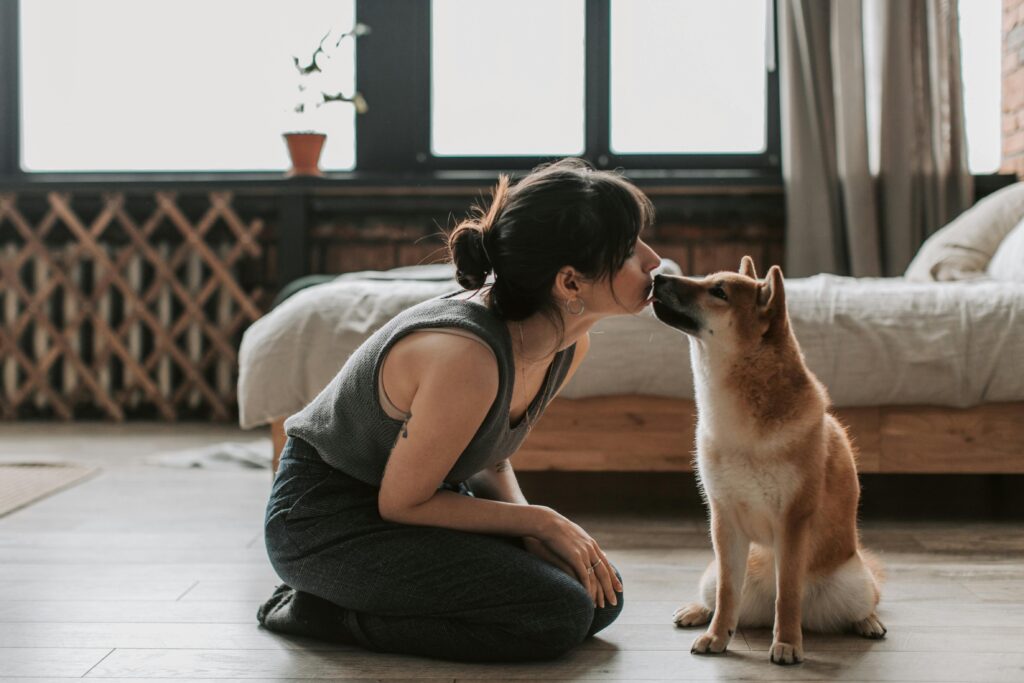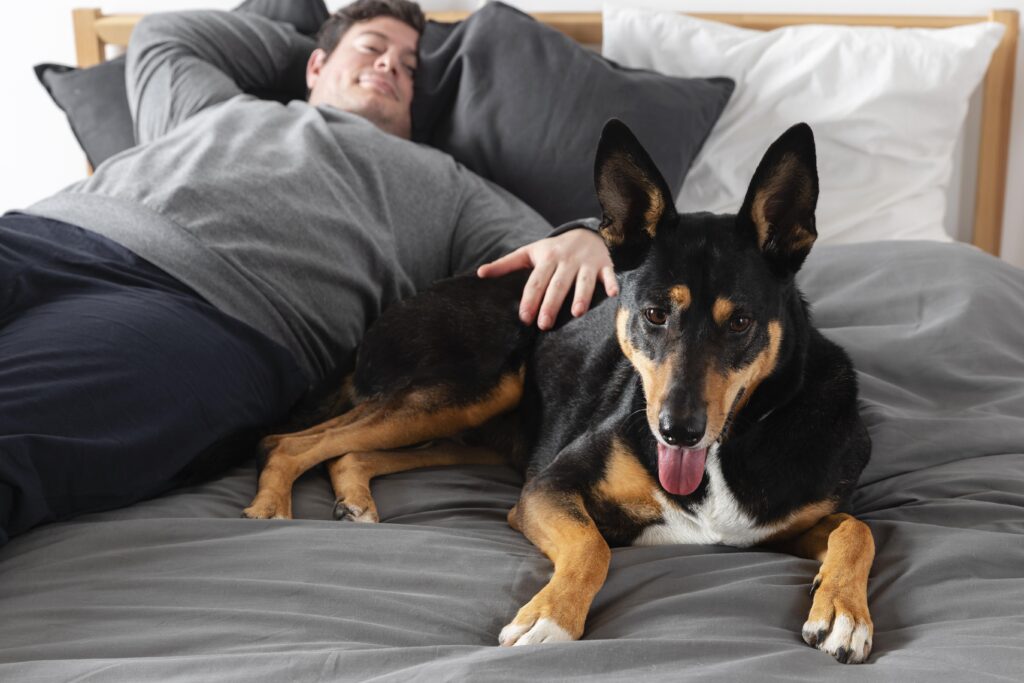Do bed bugs bite dogs? It’s a question many pet owners may wonder about, especially considering the discomfort these tiny pests can cause.
In this brief introduction, we’ll delve into whether bed bugs pose a threat to our furry companions.
The answer is somewhat reassuring for dog lovers.
While bed bugs do feed on blood, they typically prefer human hosts. However, in rare cases, they may bite dogs if no human hosts are available.
Curious about how to protect your pets from potential bed bug bites?
Here why does my dog lay on me bed on my spot.
Our upcoming article will provide expert insights from leading veterinarians and pest control specialists, ensuring you have the knowledge to keep your furry friends safe and comfortable.
Do bed bugs bite dogs?
Bed bugs can bite dogs, although they typically prefer human hosts.
When bed bugs infest a home, they can hide in bedding, furniture, and other areas where pets like dogs rest or sleep.

Bed bugs are attracted to warmth and carbon dioxide, which animals emit, making dogs potential targets for bites.
Signs that a dog may have been bitten by bed bugs include itching, redness, swelling, and small red welts on the skin.
Dogs may scratch excessively or exhibit discomfort if they have been bitten. It’s essential to monitor pets for signs of bed bug bites, especially if there is an infestation in the home.
To prevent bed bug bites on dogs, it’s crucial to address any infestations promptly through professional pest control measures.
Regularly inspecting bedding, furniture, and pet resting areas can also help detect and mitigate bed bug problems before they become severe
Here, why does my dog bite down his bed.
Picture of bed bud bites on dog
Bed bug bites on dogs can appear as small red welts or bumps on the skin.
These welts may be clustered together or scattered in various areas where the dog has been bitten. The bites can cause itching, redness, swelling, and discomfort for the dog.
Dogs may scratch or lick excessively at the bitten areas, which can lead to further irritation and potential secondary infections.
If you suspect that your dog has been bitten by bed bugs, it’s essential to consult a veterinarian for proper diagnosis and treatment.
Veterinarians can provide guidance on managing the bites and addressing any underlying bed bug infestation in your home to prevent future incidents.
WHAT BED BUG SIGNS SHOULD YOU LOOK OUT FOR?
When checking for bed bug infestations, several signs can indicate their presence:
- Bite Marks: Look for small, red, itchy welts on your skin, often in a clustered or linear pattern, particularly after waking up.
- Blood Stains: Dark or rust-colored spots on bedding, mattresses, or nearby furniture may be from crushed bed bugs or their fecal matter.
- Bed Bug Shells: Discarded exoskeletons shed by growing bed bugs are translucent and can be found near their hiding spots.
- Musty Odor: Bed bugs release pheromones that can create a distinctive, musty odor in infested areas.
- Visible Bugs: Although bed bugs are small (about the size of an apple seed), you may spot them in cracks, crevices, or hiding spots, especially during nighttime when they are more active.
Regularly inspecting bedding, furniture, and walls for these signs can help detect bed bug infestations early, allowing for prompt treatment to prevent further spread.
WHAT DO BED BUG BITES ON DOGS LOOK LIKE?
Bed bug bites on dogs can vary in appearance but often manifest as small red welts or bumps on the skin.
These bites may be clustered together or spread out in various areas where the dog has been bitten.
The affected skin can appear inflamed, swollen, and itchy. Dogs may scratch or lick excessively at the bitten areas, leading to further irritation and potential skin infections.
Here, how to clean a dog bed with pee?
It’s essential to distinguish bed bug bites on dogs from other skin conditions or allergies.
Bed bug bites typically have a distinct pattern, such as multiple bites in a line or cluster, often found on areas with less hair, like the belly, groin, or inner thighs of the dog.
If you suspect your dog has been bitten by bed bugs, consulting a veterinarian for proper diagnosis and treatment is recommended.
Does my Dog Have Bed Bugs?
To determine if your dog has bed bugs, look for signs such as small red welts or bumps on its skin, particularly in areas with less hair like the belly, groin, or inner thighs.
Bed bug bites on dogs may appear in clusters or rows.
Additionally, observe if your dog is scratching excessively, licking or chewing at its skin, or displaying signs of discomfort.
Check your dog’s bedding, blankets, and sleeping areas for dark spots (bed bug feces) or discarded exoskeletons.
If you suspect bed bugs, consult a veterinarian for a thorough examination and proper diagnosis.
Veterinarians can recommend treatments to alleviate itching, soothe skin irritation, and address any underlying infestation.
Here, how to sew a dog bed cover.
Regular grooming, cleaning of pet accessories, and maintaining a clean home environment can help prevent and manage bed bug issues for your dog.
Can Bed Bugs Transmit Disease to Dogs?
Signs of a Bed Bug Infestation
Certainly! Here are more signs of a bed bug infestation:
- Bite Marks: Small, red, itchy welts on the skin, often in clusters or rows, commonly found on exposed areas such as the face, neck, arms, and hands.
- Blood Stains: Dark or rust-colored spots on bedding, mattresses, or nearby furniture from crushed bed bugs or their feces.
- Bed Bug Shells: Discarded exoskeletons shed by molting bed bugs, typically found in hiding spots near beds or furniture.
- Musty Odor: Bed bugs release pheromones that create a distinct, sweet, musty odor in heavily infested areas.
- Visible Bugs: While bed bugs are small and nocturnal, they can be seen with the naked eye, especially in areas where infestations are severe, such as seams of mattresses, crevices in furniture, or behind wallpaper.
Regularly inspecting these areas for signs of bed bugs can help detect infestations early, facilitating prompt treatment to eliminate them effectively.
Here, why does my dog poop on my bed all of a sudden?
Treating Bed Bugs on Dogs
Treating bed bugs on dogs involves a combination of measures to alleviate bites and eliminate the infestation:
- Address Bites: Clean the affected areas with mild soap and water to reduce itching and prevent infections. Consult a veterinarian for appropriate antihistamines or topical treatments to soothe the bites.
- Pet Hygiene: Regularly groom your dog and wash their bedding and toys in hot water to remove bed bugs and their eggs.
- Environmental Control: Thoroughly clean and vacuum your home, focusing on bedding, furniture, and cracks where bed bugs hide. Use a high-heat dryer or steam cleaner on infested items to kill bed bugs.
- Professional Treatment: Consider hiring a licensed pest control professional for targeted bed bug elimination using safe and effective methods.
- Prevention: Implement preventive measures like sealing cracks, reducing clutter, and inspecting new items brought into the home to prevent future infestations.
Combining these strategies can help manage bed bugs on dogs and prevent reinfestation in your home.
Effects of Bed Bug Bites on Dogs
Bed bug bites can have several effects on dogs:
- Itching and Discomfort: Bed bug bites can cause intense itching and discomfort for dogs, leading to excessive scratching, licking, and chewing at the affected areas.
- Skin Irritation: Continuous scratching can result in skin irritation, redness, swelling, and the formation of hot spots or raw patches on the skin.
- Secondary Infections: Persistent scratching can break the skin, creating openings for bacteria to enter, potentially leading to secondary bacterial infections.
- Behavioral Changes: Dogs may exhibit changes in behavior due to the discomfort caused by bed bug bites, such as restlessness, agitation, or reluctance to be touched or handled.
- Allergic Reactions: Some dogs may be allergic to bed bug saliva, leading to more severe reactions such as hives, inflammation, or systemic allergic responses.
It’s essential to monitor and address bed bug bites promptly to alleviate discomfort, prevent skin infections, and ensure your dog’s well-being. Consulting a veterinarian for proper diagnosis and treatment is recommended.
How to get rid of bed bud on dogs
To effectively get rid of bed bugs on dogs, follow these steps:
- Bathe Your Dog: Use a gentle pet shampoo and lukewarm water to bathe your dog thoroughly, paying attention to areas where bed bugs may hide, such as between toes and under the tail.
- Trim Hair: Trim your dog’s hair, especially in areas where bed bugs are likely to hide, to reduce their hiding spots and make it easier to detect and remove them.
- Inspect and Remove Bed Bugs: Use a fine-toothed comb to carefully comb through your dog’s fur, checking for bed bugs, eggs, or fecal matter. Remove any bed bugs or debris found during combing.
- Wash Bedding and Toys: Wash your dog’s bedding, blankets, toys, and other items they frequently use in hot water and dry them on high heat to kill any remaining bed bugs or eggs.
- Consult a Veterinarian: If your dog continues to show signs of discomfort or if the infestation persists, consult a veterinarian for further guidance and potential insecticidal treatments safe for pets.
By following these steps, you can effectively eliminate bed bugs from your dog and prevent reinfestation in your home.
Here, how to keep dog fro digging in flower bed?
Can dog bring in bed buds from outside
Yes, dogs can potentially bring bed bugs from outside into your home.
While bed bugs do not typically attach themselves to pets as a primary mode of transportation, it’s still possible for them to hitch a ride on a dog’s fur or belongings.
Dogs that spend time outdoors, especially in areas where bed bugs may be present (such as infested homes, hotels, or public spaces), can inadvertently carry bed bugs into your home.
Bed bugs can cling to fur, clothing, bedding, or pet accessories like collars and blankets.
To reduce the risk of your dog bringing bed bugs indoors:
- Regularly inspect your dog’s fur and belongings after outdoor activities.
- Wash and clean your dog’s accessories frequently, especially if they’ve been in potentially infested areas.
- Maintain a clean and clutter-free home environment to minimize hiding spots for bed bugs.
Taking these precautions can help mitigate the risk of bed bug introduction from outdoor sources through your dog.
Picture of bed bud bites on dogs legs
Bed bug bites on a dog’s legs can appear as small red welts or bumps on the skin.
These welts may be clustered together or scattered in various areas where the dog has been bitten. The affected skin can become inflamed, swollen, and itchy, leading to discomfort for the dog.
Dogs may scratch or lick excessively at the bitten areas, which can exacerbate the irritation and potentially lead to secondary infections.

It’s crucial to monitor your dog for signs of bed bug bites, especially on the legs, and consult a veterinarian if you notice any unusual skin reactions or if the itching and irritation persist.
Veterinarians can provide guidance on managing the bites and addressing any underlying bed bug infestation in your home.
How can you tell if your dog has bed buds
You can tell if your dog has bed bugs by observing certain signs and behaviors:
- Bite Marks: Look for small, red welts or bumps on your dog’s skin, particularly in areas with less hair such as the belly, groin, or inner thighs. Bed bug bites on dogs often appear in clusters or rows.
- Scratching and Irritation: If your dog is scratching excessively or displaying signs of skin irritation, it could be due to bed bug bites. Dogs may also lick or chew at the bitten areas.
- Restlessness: Bed bug bites can cause discomfort and restlessness in dogs, leading to changes in their behavior such as restlessness or agitation.
- Inspecting Bedding: Check your dog’s bedding, blankets, and sleeping areas for signs of bed bugs, such as dark spots (bed bug feces) or discarded exoskeletons.
- Veterinary Examination: If you suspect your dog has bed bugs or if they are displaying unusual symptoms, consult a veterinarian for a thorough examination and proper diagnosis.
Related faq’s
How do I know if bed bugs are biting my dog?
You can tell if bed bugs are biting your dog by observing signs such as small red welts or bumps on the skin, excessive scratching or licking, restlessness or agitation, and the presence of bed bug-related evidence like dark spots (feces) or discarded exoskeletons in your dog’s bedding or sleeping areas.
If you notice these signs or suspect bed bug bites, it’s important to consult a veterinarian for proper diagnosis and treatment to ensure your dog’s well-being.
Are bed bugs harmful to dogs?
Bed bugs are not directly harmful to dogs in terms of transmitting diseases.
However, their bites can cause discomfort, itching, skin irritation, and potential allergic reactions in some dogs.
Excessive scratching due to bed bug bites can lead to skin infections or secondary issues.
While bed bugs do not pose a significant health risk to dogs compared to certain parasites or pests, it’s crucial to address infestations promptly to alleviate discomfort and prevent skin problems.
Consulting a veterinarian for proper diagnosis and treatment is advisable if you suspect your dog has been bitten by bed bugs.
Can bed bugs live on dogs?
Bed bugs do not typically live on dogs like fleas or ticks. They prefer to feed on humans and may bite dogs incidentally if no other hosts are available.
Bed bugs may temporarily hitch a ride on a dog’s fur or belongings but cannot establish a permanent infestation on pets.
They are more likely to hide in bedding, furniture, and cracks in walls rather than on animals.
Regular grooming, cleaning, and pest control measures in your home are effective ways to prevent and manage bed bug infestations, both for humans and pets.
How to stop bed bugs from biting a dog?
To prevent bed bugs from biting a dog, take these measures:
- Regular Grooming: Keep your dog’s fur clean and groomed to reduce hiding spots for bed bugs.
- Clean Bedding: Wash your dog’s bedding, blankets, and toys regularly in hot water to kill bed bugs and their eggs.
- Environmental Control: Vacuum and clean your home frequently, focusing on areas where bed bugs hide, like cracks, crevices, and furniture.
- Pest Control: Consider professional pest control treatments to eliminate bed bugs from your home.
- Monitor Signs: Regularly check your dog for signs of bites and consult a veterinarian if you suspect bed bugs.
These steps can help minimize the risk of bed bug bites on your dog and prevent infestations in your home.
Are bed bugs attracted to dogs?
Bed bugs are not primarily attracted to dogs.
They are more attracted to humans because they feed on human blood. However, in the absence of human hosts, bed bugs may bite dogs or other animals as a secondary source of blood.
Bed bugs are drawn to warmth, carbon dioxide, and body heat, which are characteristics common to mammals, including dogs.
While dogs can be bitten by bed bugs, they are not the preferred hosts.
Controlling bed bug infestations in the home and regularly grooming pets can help minimize the risk of bed bug bites on dogs.
How do you get rid of bed bugs on dogs?
To get rid of bed bugs on dogs:
- Bathe Your Dog: Use a pet-safe shampoo and warm water to thoroughly bathe your dog, paying attention to areas where bed bugs may hide.
- Inspect and Remove: Use a fine-toothed comb to check for bed bugs, eggs, or debris in your dog’s fur. Remove any bed bugs found during combing.
- Clean Environment: Wash your dog’s bedding, toys, and accessories in hot water and vacuum your home thoroughly to remove any remaining bed bugs or eggs.
- Consult a Veterinarian: If the infestation persists or your dog shows signs of discomfort, consult a veterinarian for appropriate treatments or medications.
By following these steps, you can effectively eliminate bed bugs from your dog and prevent reinfestation in your home.







